2nd Marine Division (United States)
The U.S. 2nd Marine Division is a division of the United States Marine Corps, which forms the ground combat element of the II Marine Expeditionary Force. The division is based at Marine Corps Base Camp Lejeune, North Carolina and headquartered at Julian C. Smith Hall.
The 2nd Marine Division earned renown in both World Wars, distinguishing itself at such battles as the Belleau Wood, Château-Thierry, and the Meuse-Argonne Offensive during World War I, and Guadalcanal, Tarawa, Saipan, Tinian, and Okinawa.
History
The four original regiments of the Second Marine Division – the 2nd, 6th, 8th, and 10th – were formed before the outbreak of World War I. The 2nd Marine Regiment was formed as the 1st Advance Base Regiment in Philadelphia, Pennsylvania on 19 June 1913. After actions including Vera Cruz and Haiti, the regiment was redesignated the 2nd Marine Regiment on 1 July 1916.[1] The 6th Marine Regiment was formed at Marine Corps Base Quantico, Virginia on 11 July 1917. It shipped over to France and became a part of the 4th Marine Brigade in late 1917.[2] The 8th Marine Regiment was activated 9 October 1917 at Marine Corps Base Quantico, Virginia.[3] The 10th Marine Regiment was formed up at Marine Corps Base Quantico, Virginia on 25 April 1914, and has the longest record of unbroken service of any Marine regiment.[4]
World War I
The 6th Marine Regiment was dispatched to France during late 1917 to early 1918. There, they were formed up with the 5th Marine Regiment and the 6th Machine Gun Battalion to create the 4th Marine Brigade. This brigade was attached to the 2nd Infantry Division. They participated in many of the final battles of World War I including the Aisne Defensive, Battle of Belleau Wood, Battle of Château-Thierry (1918), Battle of Saint-Mihiel, Battle of Blanc Mont Ridge, and the Meuse-Argonne Offensive. Because the marines of the 4th Marine Brigade were aggressive in both defense as well as offense during the Battle of Belleau Wood, the Germans held a very high opinion of them. In recognition of these achievements, the woods were renamed "Bois de la Brigade de Marine. In addition, the legend of the marines getting their nickname "Devil Dogs" also occurred during this battle. For recognition of their many battle accomplishments, the marines of the 5th Marine Regiment, 6th Marine Regiment, and 6th Machine Gun Battalion were awarded the French croix de guerre three times. As a result, these units are authorized to wear the fourragère of the croix de guerre (seen in the unit's logo). The fourragère thereafter became part of the uniform of these units, and all members of the modern 5th and 6th Marine Regiments are authorized to wear the fourragère while serving with the regiment.
World War II
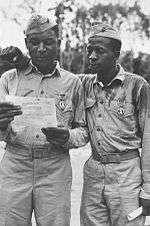
Major General Clayton B. Vogel, its first commander, activated the 2d Marine Division at a parade and review at the Marine Corps Base, San Diego, California, during a sunny Saturday afternoon of 1 February 1941. The division consisted of the 2d, 6th, and 8th Marines infantry regiments; the 10th Marines, an artillery regiment; engineer, medical, service, and tank battalions; and transport, signal, chemical, and antiaircraft machine gun companies.[5] By mid-1941, because of the growing threat of a German invasion to Iceland, the 6th Marine Regiment, a battalion from 10th Marines and other scattered units were pulled from the division and sent to garrison Reykjavík. After the outbreak of war the 8th Marine Regiment with an assortment of other division assets formed the 2nd Marine Brigade and were dispatched to garrison American Samoa.[6]
During World War II, the 2nd Marine Division (Headquarters) participated in operations in the Pacific Theater of Operations:
- The Guadalcanal Campaign, in the Solomon Islands campaign – 4 January to 8 February 1943.
- 2d Marines, reinforced:
Guadalcanal-Tulagi landings, 7 to 9 August 1942;
capture and defense of Guadalcanal, 10 August 1942 to 31 January 1943. - 8th Marines, reinforced:
capture and defense of Guadalcanal, 2 November 1942 to 8 February 1943.
- 2d Marines, reinforced:
- The Battle of Tarawa, in the Gilbert Islands campaign – 20 November to 4 December 1943.
- The Battle of Saipan, in the Mariana Islands campaign – 15 June to 24 July 1944.
- The Battle of Tinian, – 24 July to 10 August 1944.
- The Battle of Okinawa (floating Reserve) – 1 April to 10 April 1945. (Detachment of Headquarters and the 8th Marines, reinforced, from 1 to 30 June 1945).
Elements of the Division were part of the occupation of Nagasaki, arriving twenty-five days after the nuclear strike.
The 2nd and 8th Marines (reinforced by other units of the 2nd Marine Division) were awarded the Presidential Unit Citation while attached to the 1st Marine Division from 7 August and 4 November 1942, respectively, for the Guadalcanal operation.
The 2nd Marine Division was awarded the Presidential Unit Citation for Tarawa Atoll, Gilbert Islands, 20 –24 November 1943: "For outstanding performance in combat during the seizure and occupation of the Japanese-held Atoll of Tarawa, Gilbert Islands, November 20 to 24, 1943. Forced by the treacherous coral reefs to disembark from their landing craft hundreds of yards off the beach, the Second Marine Division (Reinforced) became a highly vulnerable target for devastating Japanese fire. Dauntlessly advancing in spite of rapidly mounting losses, the Marines fought a gallant battle against crushing odds, clearing the limited beachheads of snipers and machine guns, reducing powerfully fortified enemy positions and completely annihilating the fanatically determined and strongly entrenched Japanese forces. By the successful occupation of Tarawa, the Second Marine Division (Reinforced) has provided our forces with highly strategic and important air and land bases from which to continue future operations against the enemy; by the valiant fighting spirit of these men, their heroic fortitude under punishing fire and their relentless perseverance in waging this epic battle in the Central Pacific, they have upheld the finest traditions of the United States Naval Service."
1950s through the 1980s
The Division didn't take part in a major action again until 1958 when elements participated in the U.S. intervention into the Lebanon crisis of 1958. 2nd Marine Division units helped to reinforce Guantanamo Bay during the Cuban Missile Crisis in 1962 and landed in the Dominican Republic in 1965 as part of Operation Power Pack. Other peacekeeping operations carried on by the Division include being part of the Multi National Peacekeeping Force in Lebanon from August 1982 until February 1984. The Division suffered the loss of 241 Marines and Sailors during the 1983 Beirut barracks bombing. Towards the end of the 1980s, Division Marines participated in Operation Just Cause, the invasion of Panama.
The Gulf War & the 1990s
The 1990s began with elements of the Division participating in Operation Sharp Edge, the evacuation of American and allied civilians out of war torn Liberia. This was followed by deployments to Saudi Arabia in support of Operation Desert Shield and then the liberation of Kuwait in Operation Desert Storm. The 2nd Marine Division played a major role repelling the attempted Iraqi invasion of Saudi Arabia which is known as the Battle of Khafji. The 2nd Marine Division faced heavy resistance during the Battle of Kuwait International Airport. Marine Reserve unit Bravo Company, 4th Tank Battalion, 4th Marine division was assigned to the 2nd Marine Division. On February 25, 1991, Day 2 of the Desert Storm ground war, Bravo Company 4th Tank Battalion was in a coil formation and awakened from a 25% watch to find 35 Iraqi Republican Guard tanks angling across their front, not realizing at the time that they were outnumbered 3-1. With their 13 M1A1 Abrams tanks, Bravo Company 4th Tank Battalion moved online to take out the 35 Iraqi Republican Guard tanks in less than 90 seconds. This battle was named the "Reveille Engagement" and went on to be the biggest and fastest tank battle in United States Marine Corps history. [7] Bravo company went on to destroy 59 tanks, 32 APCs, 26 non armored vehicles, and an artillery gun.[8] Bravo Company destroyed a total of 119 enemy vehicles and took over 800 POWs.[9] Tank crew "Stepchild" has the longest confirmed live kill (Iraqi BMP) by a tank at 3,750 meters (2.33miles).[10] On the second day of the U.S. advance a platoon from the Marine 8th Battalion destroyed 13 Iraqi tanks in a battle near a defensive position known as the Ice Tray.[11] Marine and Navy air power then inflicted heavy casualties on retreating Iraqi forces leading north out of Kuwait City.[12] The 1st Tank Battalion claimed 50 Iraqi T-55 and T-62 tanks and 25 APCs. The 3rd Battalion claimed 57 T-55s and T-62s(plus 5 T-72s), 7 APCs, and 10 trucks. The 8th Battalion destroyed more than three dozen tanks and a number of other vehicles.[13] On the third and final day of combat the 2nd Marine Division would liberate the city of Al Jahra then would go on to occupy the high ground on the Mutla Ridge cutting off the Iraqi escape route from Kuwait to Basra. Following the war, elements of the Division participated in Operation Provide Comfort.
Global War on Terror

Elements of the 2nd Marine Division deployed to Kuwait in early 2003 to reinforce the 1st Marine Expeditionary Force. These units formed a Marine Expeditionary Brigade (MEB) and were called Task Force Tarawa. Task Force Tarawa crossed into Iraq on the first day of the ground war with the initial task of seizing Jalibah airfield in southern Iraq. Following this, the Task Force pushed north and took part in a major battle in the town of Nasiriyah. After the war, these Marines were moved north to Al Kut where they provided security and stabilization operations in central Iraq.
The 2nd Marine Division deployed to Camp Fallujah, Iraq as the II Marine Expeditionary Force (II MEF) headquarters in January 2005 as part of Operation Iraqi Freedom III (OIF III) (later redesignated OIF 04-06) to relieve the 1st Marine Division in the Al Anbar province. The division again deployed for another year-long tour at Camp Fallujah from 2007 to 2008.
Subordinate units
As of 2008, the 2nd Marine Division is composed of:
-
 Headquarters Battalion
Headquarters Battalion -
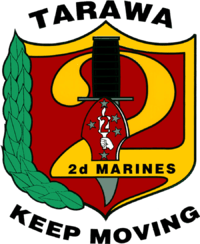 2nd Marine Regiment
2nd Marine Regiment -
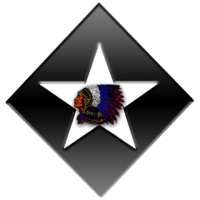 6th Marine Regiment
6th Marine Regiment -
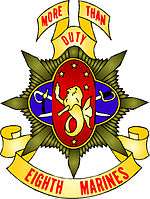 8th Marine Regiment
8th Marine Regiment -
 10th Marine Regiment
10th Marine Regiment -
 2nd Assault Amphibian Battalion
2nd Assault Amphibian Battalion -
 2nd Combat Engineer Battalion
2nd Combat Engineer Battalion -
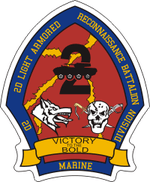 2nd Light Armored Reconnaissance Battalion
2nd Light Armored Reconnaissance Battalion -
 2nd Reconnaissance Battalion
2nd Reconnaissance Battalion -
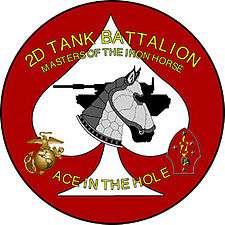 2nd Tank Battalion
2nd Tank Battalion

Insignia
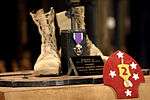
The scarlet and gold spearhead-shaped shoulder patch was designed and authorized in late 1943 for wear by 2nd Marine Division units serving in the Pacific Theater. The patch centers on a hand holding a torch, with the stars of the Southern Cross constellation as a reference to Guadalcanal.[14]
Although the Marine Corps officially disallowed shoulder patches in 1947, the insignia still appears on buildings, signs, documents, and non-uniform clothing.[15] The insignia of Marine Corps Base Camp Lejeune retains the spearhead shape and general color scheme of the 2nd Marine Division.[16]
Unit awards
A unit citation or commendation is an award bestowed upon an organization for the action cited. Members of the unit who participated in said actions are allowed to wear on their uniforms the awarded unit citation. The 2nd Marine Division has been presented with the following awards:[17]
| Presidential Unit Citation | |
| Navy Unit Commendation | |
| Marine Corps Expeditionary Medal | |
| American Defense Service Medal with one bronze star | |
| Asiatic-Pacific Campaign Medal with one silver Star and three bronze stars | |
| World War II Victory Medal | |
| Navy Occupation Service Medal with Asia & European clasps | |
| National Defense Service Medal with two bronze stars | |
| Armed Forces Expeditionary Medal with two bronze stars | |
| Southwest Asia Service Medal with three bronze stars | |
| Iraq Campaign Medal | |
| Global War on Terrorism Expeditionary Medal | |
| Global War on Terrorism Service Medal |
See also
| Wikimedia Commons has media related to 2nd Marine Division (United States). |
Notes
- ↑ http://www.marines.mil/unit/2ndmardiv/2ndmarreg/Pages/History/default.aspx
- ↑ http://www.marines.mil/unit/2ndmardiv/6thmarreg/Pages/History/default.aspx
- ↑ http://www.marines.mil/unit/2ndmardiv/8thmarreg/Pages/History/default.aspx
- ↑ http://www.marines.mil/unit/2ndmardiv/10thmarreg/Pages/History/default.aspx
- ↑ #Johnston (1948), p.7.
- ↑ #Johnston (1948), p.13-14.
- ↑ bravocompany4thtankbattalion.org
- ↑ Semper Fi: The Definitive Illustrated History of the U.S. Marines by Chenoweth p.408
- ↑ bravocompany4thtankbattalion.org
- ↑ bravocompany4thtankbattalion.org
- ↑ M60 vs T-62 Cold War Combatants 1956-92 Nordeen&Isby P.72
- ↑ Semper Fi: The Definitive Illustrated History of the U.S. Marines by Chenoweth p.408
- ↑ M60 vs T-62 Cold War Combatants 1956-92 Nordeen&Isby P.73
- ↑ Heritage Years: Second Marine Division, 1940–1999. Turner Publishing Company. p. 21. ISBN 1-56311-501-8.
- ↑ Russell, Lee (1984). The US Marine Corps since 1945. Osprey Publishing. p. 38. ISBN 0-85045-574-X.
- ↑ "Marine Corps Base Camp Lejeune". Retrieved 4 December 2009.
- ↑ "Lineage of the 2nd Marine Division". 2nd Marine Division Association. Retrieved 8 June 2008.
References
- Col H. Avery Chenoweth (2005) Semper Fi: The Definitive Illustrated History of the U.S. Marines
- M60 vs T-62 Cold War Combatants 1956-92 by Lon Nordeen & David Isby
 This article incorporates public domain material from websites or documents of the United States Marine Corps.
This article incorporates public domain material from websites or documents of the United States Marine Corps.
- Bibliography
- Johnston, Richard (1948). Follow Me: The Story of the Second Marine Division in World War II. New York: Random House. ASIN B000WLAD86.
- Web
- 2nd Marine Division official website
- 2nd Marine Division Association
- Battle Honors of the Six Marine Divisions in World War II
- Crawford, Danny J.; Robert V. Aquilina; Ann A. Ferrante; Lena M. Kaljot; Shelia P. Gramblin (2001). "The 2d Marine Division and Its Regiments". History & Museams Division. United States Marine Corps. Archived from the original on 11 December 2008. Retrieved 3 December 2008.
- World War II Gyrene

